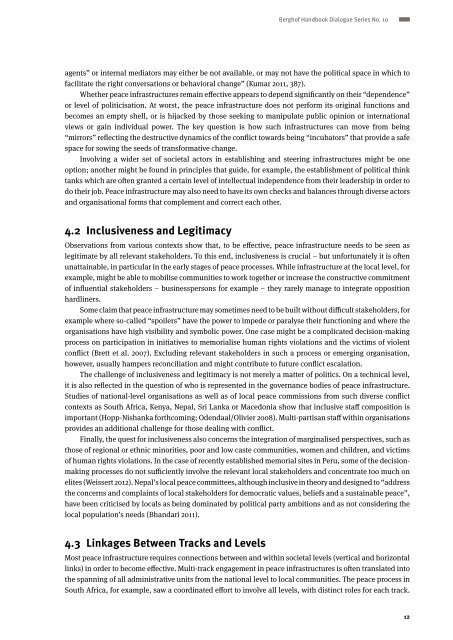Giving Peace an Address? - Berghof Handbook for Conflict ...
Giving Peace an Address? - Berghof Handbook for Conflict ...
Giving Peace an Address? - Berghof Handbook for Conflict ...
Create successful ePaper yourself
Turn your PDF publications into a flip-book with our unique Google optimized e-Paper software.
<strong>Berghof</strong> H<strong>an</strong>dbook Dialogue Series No. 10<br />
agents” or internal mediators may either be not available, or may not have the political space in which to<br />
facilitate the right conversations or behavioral ch<strong>an</strong>ge” (Kumar 2011, 387).<br />
Whether peace infrastructures remain effective appears to depend signific<strong>an</strong>tly on their “dependence”<br />
or level of politicisation. At worst, the peace infrastructure does not per<strong>for</strong>m its original functions <strong>an</strong>d<br />
becomes <strong>an</strong> empty shell, or is hijacked by those seeking to m<strong>an</strong>ipulate public opinion or international<br />
views or gain individual power. The key question is how such infrastructures c<strong>an</strong> move from being<br />
“mirrors” reflecting the destructive dynamics of the conflict towards being “incubators” that provide a safe<br />
space <strong>for</strong> sowing the seeds of tr<strong>an</strong>s<strong>for</strong>mative ch<strong>an</strong>ge.<br />
Involving a wider set of societal actors in establishing <strong>an</strong>d steering infrastructures might be one<br />
option; <strong>an</strong>other might be found in principles that guide, <strong>for</strong> example, the establishment of political think<br />
t<strong>an</strong>ks which are often gr<strong>an</strong>ted a certain level of intellectual independence from their leadership in order to<br />
do their job. <strong>Peace</strong> infrastructure may also need to have its own checks <strong>an</strong>d bal<strong>an</strong>ces through diverse actors<br />
<strong>an</strong>d org<strong>an</strong>isational <strong>for</strong>ms that complement <strong>an</strong>d correct each other.<br />
4.2 Inclusiveness <strong>an</strong>d Legitimacy<br />
Observations from various contexts show that, to be effective, peace infrastructure needs to be seen as<br />
legitimate by all relev<strong>an</strong>t stakeholders. To this end, inclusiveness is crucial – but un<strong>for</strong>tunately it is often<br />
unattainable, in particular in the early stages of peace processes. While infrastructure at the local level, <strong>for</strong><br />
example, might be able to mobilise communities to work together or increase the constructive commitment<br />
of influential stakeholders – businesspersons <strong>for</strong> example – they rarely m<strong>an</strong>age to integrate opposition<br />
hardliners.<br />
Some claim that peace infrastructure may sometimes need to be built without difficult stakeholders, <strong>for</strong><br />
example where so-called “spoilers” have the power to impede or paralyse their functioning <strong>an</strong>d where the<br />
org<strong>an</strong>isations have high visibility <strong>an</strong>d symbolic power. One case might be a complicated decision-making<br />
process on participation in initiatives to memorialise hum<strong>an</strong> rights violations <strong>an</strong>d the victims of violent<br />
conflict (Brett et al. 2007). Excluding relev<strong>an</strong>t stakeholders in such a process or emerging org<strong>an</strong>isation,<br />
however, usually hampers reconciliation <strong>an</strong>d might contribute to future conflict escalation.<br />
The challenge of inclusiveness <strong>an</strong>d legitimacy is not merely a matter of politics. On a technical level,<br />
it is also reflected in the question of who is represented in the govern<strong>an</strong>ce bodies of peace infrastructure.<br />
Studies of national-level org<strong>an</strong>isations as well as of local peace commissions from such diverse conflict<br />
contexts as South Africa, Kenya, Nepal, Sri L<strong>an</strong>ka or Macedonia show that inclusive staff composition is<br />
import<strong>an</strong>t (Hopp-Nish<strong>an</strong>ka <strong>for</strong>thcoming; Odendaal/Olivier 2008). Multi-partis<strong>an</strong> staff within org<strong>an</strong>isations<br />
provides <strong>an</strong> additional challenge <strong>for</strong> those dealing with conflict.<br />
Finally, the quest <strong>for</strong> inclusiveness also concerns the integration of marginalised perspectives, such as<br />
those of regional or ethnic minorities, poor <strong>an</strong>d low caste communities, women <strong>an</strong>d children, <strong>an</strong>d victims<br />
of hum<strong>an</strong> rights violations. In the case of recently established memorial sites in Peru, some of the decisionmaking<br />
processes do not sufficiently involve the relev<strong>an</strong>t local stakeholders <strong>an</strong>d concentrate too much on<br />
elites (Weissert 2012). Nepal’s local peace committees, although inclusive in theory <strong>an</strong>d designed to “address<br />
the concerns <strong>an</strong>d complaints of local stakeholders <strong>for</strong> democratic values, beliefs <strong>an</strong>d a sustainable peace”,<br />
have been criticised by locals as being dominated by political party ambitions <strong>an</strong>d as not considering the<br />
local population’s needs (Bh<strong>an</strong>dari 2011).<br />
4.3 Linkages Between Tracks <strong>an</strong>d Levels<br />
Most peace infrastructure requires connections between <strong>an</strong>d within societal levels (vertical <strong>an</strong>d horizontal<br />
links) in order to become effective. Multi-track engagement in peace infrastructures is often tr<strong>an</strong>slated into<br />
the sp<strong>an</strong>ning of all administrative units from the national level to local communities. The peace process in<br />
South Africa, <strong>for</strong> example, saw a coordinated ef<strong>for</strong>t to involve all levels, with distinct roles <strong>for</strong> each track.<br />
12
















